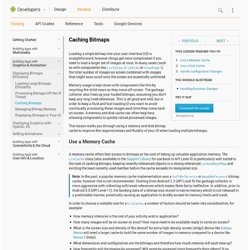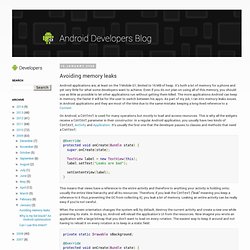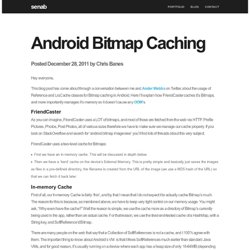

Managing Bitmap Memory. In addition to the steps described in Caching Bitmaps , there are specific things you can do to facilitate garbage collection and bitmap reuse.

The recommended strategy depends on which version(s) of Android you are targeting. The BitmapFun sample app included with this class shows you how to design your app to work efficiently across different versions of Android. To set the stage for this lesson, here is how Android's management of bitmap memory has evolved: On Android Android 2.2 (API level 8) and lower, when garbage collection occurs, your app's threads get stopped. This causes a lag that can degrade performance. Caching Bitmaps. Loading a single bitmap into your user interface (UI) is straightforward, however things get more complicated if you need to load a larger set of images at once.

In many cases (such as with components like ListView , GridView or ViewPager ), the total number of images on-screen combined with images that might soon scroll onto the screen are essentially unlimited. Memory usage is kept down with components like this by recycling the child views as they move off-screen. The garbage collector also frees up your loaded bitmaps, assuming you don't keep any long lived references.
This is all good and well, but in order to keep a fluid and fast-loading UI you want to avoid continually processing these images each time they come back on-screen. A memory and disk cache can often help here, allowing components to quickly reload processed images. This lesson walks you through using a memory and disk bitmap cache to improve the responsiveness and fluidity of your UI when loading multiple bitmaps. Avoiding memory leaks. Android applications are, at least on the T-Mobile G1, limited to 16 MB of heap.

It's both a lot of memory for a phone and yet very little for what some developers want to achieve. Even if you do not plan on using all of this memory, you should use as little as possible to let other applications run without getting them killed. The more applications Android can keep in memory, the faster it will be for the user to switch between his apps. As part of my job, I ran into memory leaks issues in Android applications and they are most of the time due to the same mistake: keeping a long-lived reference to a Context. On Android, a Context is used for many operations but mostly to load and access resources. @Overrideprotected void onCreate(Bundle state) { super.onCreate(state); TextView label = new TextView(this); label.setText("Leaks are bad"); setContentView(label);} private static Drawable sBackground; In summary, to avoid context-related memory leaks, remember the following:
Memory Analysis for Android Applications. [This post is by Patrick Dubroy, an Android engineer who writes about programming, usability, and interaction on his personal blog. — Tim Bray] The Dalvik runtime may be garbage-collected, but that doesn't mean you can ignore memory management.

Android - How can I destroy the WebView Activity and the video in WebView. Android - Memory leak in WebView. Android - Why does EditText retain its Activity's Context in Ice Cream Sandwich. Android Bitmap Caching. Hey everyone, This blog post has come about through a conversation between me and Ander Webbs on Twitter, about the usage of Reference and LruCache classes for Bitmap caching in Android.

Here I’ll explain how FriendCaster caches it’s Bitmaps, and more importantly manages it’s memory so it doesn’t cause any OOM ‘s. FriendCaster As you can imagine, FriendCaster uses a LOT of bitmaps, and most of those are fetched from the web via HTTP. Profile Pictures, Photos, Post Photos, all of various sizes therefore we have to make sure we manage our cache properly. Google I/O: Memory Management for Android Apps. May 16, 2011 ⋅ android ⋅ 5 Comments » Though I never made a formal announcement here, some of you may know that I joined the Android team at Google just over a year ago.

Last week I had the privilege of speaking at Google I/O in a talk called “Memory Management for Android Applications”: Android apps have more memory available to them than ever before, but are you sure you’re using it wisely? This talk will cover the memory management changes in Gingerbread and Honeycomb (concurrent GC, heap-allocated bitmaps, “largeHeap” option) and explore tools and techniques for profiling the memory usage of Android apps.
You can watch a full video of the talk (including the Q&A) on YouTube: You can also download the slides (PDF). ERRATUM: I’d like to correct one mistake I made in the Q&A, answering a question at 49:33 in the video. Anyways, I had a great time at Google I/O, and met all kinds of developers building cool stuff on Android. Java - How to discover memory usage of my application in Android. Eclipse Memory Analyzer, 10 useful tips/articles. Thursday, July 09, 2009 Eclipse Memory Analyzer, 10 useful tips/articles The Eclipse Memory Analyzer has been shipped with Eclipse 3.5 Galileo and I planned to start a new series here about memory usage antipatterns and how to analyze them with MAT.

Unfortunately I'm pretty busy these days and I will need more time for those posts. But, due to popular demand I decided it would make sense to post some good links (ok, I admit some of them are from myself) about how to use the Eclipse Memory Analyzer. Please forgive me if I missed some important ones, but I'm really hungry now and therefore just stopped after 10 tips ;) How to really measure memory usage : The absolute fundamentals Check the online help.
Unter 1:35 PM Email This BlogThis! Labels: memory Gepostet von Markus Kohler 40 comments: Philip said... #6 seems to link to #5 in your list July 10, 2009 at 7:25:00 AM PDT Markus Kohler said... Thanks for the hint! July 10, 2009 at 7:48:00 AM PDT Felipe Silveira said... Great article, Markus. 去哪呢? Android memory usage analysis slides available.